White wagtail
| White wagtail | |
|---|---|
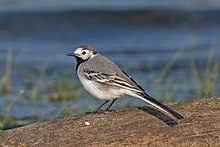
| |
| Female, first summer | |
| Scientific classification | |
| Domain: | Eukaryota |
| Kingdom: | Animalia |
| Phylum: | Chordata |
| Class: | Aves |
| Order: | Passeriformes |
| Family: | Motacillidae |
| Genus: | Motacilla |
| Species: | M. alba
|
| Binomial name | |
| Motacilla alba | |

| |
| Global map of eBird reports Year-round range Summer range Winter range
| |
The white wagtail (Motacilla alba) is a small
The white wagtail is an insectivorous bird of open country, often near habitation and water.[6] It prefers bare areas for feeding, where it can see and pursue its prey. In urban areas, it has adapted to foraging on paved areas such as car parks. It nests in crevices in stone walls and similar natural and human-made structures.[6]
It is the national bird of Latvia and has featured on the stamps of several countries.[7] Though it is 'of least concern', there are several threats against it, like being kept as pets and being used as food.
Taxonomy and systematics

The white wagtail was one of the many species originally described by
Within the wagtail genus Motacilla, the white wagtail's closest genetic relatives appear to be other black-and-white wagtails such as the
Description

The white wagtail is a slender bird, 16.5 to 19 cm (6.5 to 7.5 in) in length (East Asian subspecies are longer, measuring up to 21 cm (8.3 in)), with the characteristic long, constantly wagging tail of its genus. Its average weight is 25 g (0.88 oz) and the maximum lifespan in the wild is about 12 years.[14]
There are a number of other subspecies, some of which may have arisen because of partial geographical isolation, such as the resident British and Irish form, the pied wagtail M. a. yarrellii, which now also breeds in adjacent areas of the neighbouring European mainland. The pied wagtail, named for naturalist William Yarrell, exchanges the grey colour of the nominate form with black (or very dark grey in females), but is otherwise identical in its behaviour. Other subspecies, the validity of some of which is questionable, differ in the colour of the wings, back, and head, or other features. Some races show sexual dimorphism during the breeding season. As many as six subspecies may be present in the wintering ground in India or Southeast Asia and here they can be difficult to distinguish.[15][16][17][18] Phylogenetic studies using mtDNA suggest that some morphological features have evolved more than once, including the back and chin colour. Breeding M. a. yarrellii look much like the nominate race except for the black back, and M. a. alboides of the Himalayas differs from the Central Asian M. a. personata only by its black back. M. a. personata has been recorded breeding in the Siddar Valley of Kashmir of the Western Himalayas.[19] It has also been noted that both back and chin change colour during the pre-basic moult; all black-throated subspecies develop white chins and throats in winter and some black-backed birds are grey-backed in winter.[12][15]
The call of the white wagtail is a sharp chisick, slightly softer than the version given by the pied wagtail. The song is more regular in white than pied, but with little territorial significance, since the male uses a series of contact calls to attract the female.[20]
Subspecies
Nine or eleven subspecies are currently recognised. This is because the black backed wagtail may be a separate species and M. a. dukhunensis may be part of M. a. alba. Information on the plumage differences and distribution of the subspecies of the white wagtail is shown below.[21]
| Subspecies | Range | Notes | Image |
|---|---|---|---|
| M. a. alba | Europe from the Iberian Peninsula to Ural Mountains, Turkey, the Levant, Iceland, the Faroe Islands and Greenland's eastern coast. Some migrate to the south of Europe and Africa down as far as Kenya and Malawi. Occasionally, they are found in Britain. | Nominotypical subspecies | 
|
| M. a. yarrellii | Great Britain and Ireland, birds in the northern part of the range winter in Spain and North Africa, those further south are resident.[22] | Pied wagtail or water wagtail. Has a much blacker back than the nominate race, black of throat continues on side of neck | 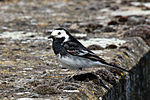
|
| M. a. dukhunensis | West Siberian Plain – east Caspian Sea (part of Russia, Kazakhstan, Uzbekistan, Turkmenistan), winters in the Middle East, India and Bangladesh. Sometimes included in alba.[22] | Indian pied wagtail. The upperparts of this subspecies are paler and more blue-grey than nominate, and has it has a continuous unbroken white panel on wing coverts. | |
| M. a. persica | North central and western Iran. | Intermediate between M. a. dukhunensis and M. a. personata. Often included in alba; appears to be hybrid or intergrade population.[22] | 
|
| M. a. subpersonata | Non-migratory resident of Morocco | Moroccan wagtail. It has more black on the head than the nominate, and resembles a grey-backed, white-throated African pied wagtail[22] | 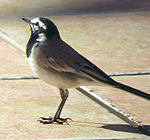
|
| M. a. personata | Altay Mountains (northern Iran, Afghanistan, Tajikistan, Kyrgyzstan, Kazakhstan, Xinjiang )
|
Masked wagtail. All-black head with a white face mask | 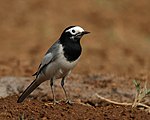
|
| M. a. alboides | Himalayas and surrounding area | This subspecies has a black back and a lot of black around the head, a white wing panel and white edges on the secondaries and tertials. | 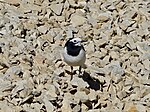
|
| M. a. baicalensis | Russia in Lake Baikal area, Mongolia, Inner Mongolia | Resembles M. a. leucopsis but grey back and less white on head and wing. | 
|
| M. a. ocularis | Siberia, Far Eastern (Russia, eastwards from Central Siberian Plateau) expanding into West Alaska | Similar to M. a. lugens, but with an all grey rump, clearer blue-grey and darker gray back.[23] | |
| M. a. lugens | Russia Far East ( Honshū )
|
Black-backed wagtail or Kamchatka/Japanese pied wagtail, similar to M. a. yarrellii, but has a black eyestripe and white remiges ; might have a claim to constitute a distinct species.
|
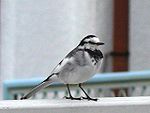
|
| M. a. leucopsis | China, | Amur wagtail[24][25][26] | 
|
The British subspecies Motacilla alba yarellii was named after
Distribution and habitat

This species breeds throughout Eurasia up to latitudes 75°N, only being absent in the
Behaviour and ecology
The most conspicuous habit of this species is a near-constant tail wagging, a trait that has given the species, and indeed the genus, its common name. In spite of the ubiquity of this behaviour, the reasons for it are poorly understood. It has been suggested that it may flush prey, or signal submissiveness to other wagtails. A study in 2004 has suggested instead that it is a signal of vigilance to potential predators.[30]
Diet and feeding
The exact composition of the diet of white wagtails varies by location, but terrestrial and aquatic
Breeding

White wagtails are
Though it is known to be a host species for the
Status
This species has a large range, with an estimated extent of more than 10 million square kilometres (3.9 million square miles). The population size is between 130 and 230 million.[1] Population trends have not been quantified, but the species is not believed to approach the thresholds for the population decline criterion of the
In culture
They have featured on stamps from Bahrain, Belarus, Belgium, Finland, Georgia, Hong Kong, Hungary, Iceland, Iran, Ireland, Israel, Jersey, Kuwait, Latvia, Norway, Poland, the United Kingdom and Vietnam.[36] The white wagtail is the national bird of Latvia, and has been often mentioned in Latvian folk songs.[7]
References
- ^ . Retrieved 8 August 2021.
- ^ Water wagtail collinsdictionary.com
- ISBN 9781785373206– via Google Books.
- ^ Colton, Stephen (February 23, 2019). "Take on Nature: Pied Wagtails make a poignant appearance". The Irish News.
- ^ Ashdown, Robert (July 3, 2012). "The spirited Wagtail".
- ^ a b c Hunter, Fact (2013-03-18). "Bird's Lifestyle: White Wagtail - National Bird of Latvia". Bird's Lifestyle. Retrieved 2019-01-18.
- ^ a b "Symbols". [Latvia.eu]. 2015-01-13. Retrieved 2019-01-18.
- ^ Linnaeus, Carl (1758). Systema naturae per regna tria naturae, secundum classes, ordines, genera, species, cum characteribus, differentiis, synonymis, locis. Tomus I. Editio decima, reformata (in Latin). Holmiae. (Laurentii Salvii). p. 185.
M. pectore nigro, recticibus duabus lateralibus dimidiato oblique albis.
- ISBN 978-0-19-854634-4.
- ^ "Latin Definitions for: Alba (Latin Search) - Latin Dictionary and Grammar Resources - Latdict". www.latin-dictionary.net.
white, pale...(adjective#1, definition 3)
- S2CID 85844839.
- ^ .
- ^ Odeen, A.; Alstrom, P. (2001). "Evolution of secondary traits in wagtails (genus Motacilla)". Effects of post-glacial range expansion and population bottlenecks on species richness (PhD). Uppsala University.
- .
- ^ a b Alstrom, P. & Mild, K. (2003). Pipits and wagtails. Princeton University Press.
- ^ Akhtar, Syed Asad; Prakash, Vibhu (1989). "Streakeyed Pied Wagtail, Motacilla alba ocularis Swinhoe from Harike Lake, Punjab". Journal of the Bombay Natural History Society. 86 (2): 246.
- ^ Ticehurst, CB (1922). "Notes on Indian wagtails". Journal of the Bombay Natural History Society. 28 (4): 1082–1090.
- ^ Pittie, Aasheesh; Kulkarni, MS; Mathew, Rajeev (1998). "Range extension of White Wagtail Motacilla alba leucopsis at Pocharam Lake, Medak District, Andhra Pradesh". Journal of the Bombay Natural History Society. 95 (2): 347–348.
- ^ Fenton, LL (1910). "Breeding of the Masked Wagtail (Motacilla personata) in Kashmir". J. Bombay Nat. Hist. Soc. 19 (4): 992.
- ^ ISBN 978-0002198714.
- ^ Nakamura, Kazue (1985). "Historical change of the geographical distribution of two closely related species of the genus Motacilla in the Japanese Archipelago: a preliminary note". Bulletin of the Kanagawa Prefecture Museum of Natural Science (in Japanese). 16.
- ^ ISBN 978-8487334696.
- .
- ^ British Ornithologists' Union Records Committee; British Birds Rarities Committee (22 July 2009). "Changes to Category A of the British List". BOU News. British Ornithologists' Union. Retrieved 22 July 2009.
- ^ Addinall, Stephen (May 2010). "'Amur Wagtail' in County Durham: new to Britain and the Western Palearctic" (PDF). British Birds. 103: 260–267.
- ^ Rowlands, Adam (May 2010). "Proposed criteria for BBRC assessment of claims of 'Amur Wagtail'". British Birds. 103: 268–275.
- ^ ISBN 978-0-19-854099-1.
- ISBN 978-0-00-714705-2.
- ISBN 978-1873403983.
- S2CID 53189368.
- JSTOR 3777.
- ^ S2CID 83483724. Retrieved 16 April 2010.
- JSTOR 1365667.
- ^ Paul Guillet; Nicole Bouglouan. "White Wagtail". Oiseaux-Birds.
- ^ Moksnes, Arne; Eivin Roskaft; Anders T. Braa (April 1991). "Rejection Behavior by Common Cuckoo Hosts Towards Artificial Brood Parasite Eggs" (PDF). Auk. 108 (2): 248–254.
- ^ Chris Gibbons. "White Wagtail stamps". www.bird-stamps.org. Archived from the original on October 1, 2000.
{{cite web}}: CS1 maint: unfit URL (link)
External links
- Videos, photos and sounds on the Internet Bird Collection
- Masked, pied and white wagtail photos - Norwegian Cyberbirding
- "Pied Wagtail... The Gipsy Bird" Pied wagtails in Welsh Romaniculture - Romani Rise
- Identification article with pictures (PDF)
- Ageing and sexing (PDF; 4.9 MB) by Javier Blasco-Zumeta & Gerd-Michael Heinze Archived 2016-11-08 at the Wayback Machine


